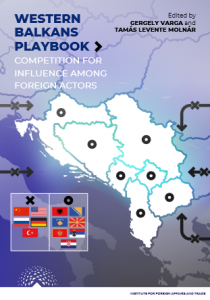A Külügyi és Külgazdasági Intézet kiadványa (Budapest, 2021). A kötet a legfontosabb külső szereplők (USA, Oroszország, Németország, Törökország és Kína) nyugat-balkáni politikáját és jelenlétét vizsgálja, továbbá hasonlítja össze.
Szerkesztő: Varga Gergely és Molnár Tamás Levente
Szerzők: Dr. Varga Gergely – Külügyi és Külgazdasági Intézet Molnár Tamás Levente – Külügyi és Külgazdasági Intézet Ackermann Sándor – Diplomata Brüsszelben Egeresi Zoltán – Külügyi és Külgazdasági Intézet Peragovics Tamás – Közgazdaság- és Regionális Tudományi Kutatóközpont Világgazdasági Intézet Szunomár Ágnes – Közgazdaság- és Regionális Tudományi Kutatóközpont Világgazdasági Intézet
A teljes angol nyelvű kötet itt érhető el!
China in the Western Balkans: Geopolitics with Chinese Characteristics?
Tamás Peragovics and Ágnes Szunomár
pp 139-166
China’s role as a global investor and financier has grown rapidly in recent decades, including in Europe. From German robot manufacturers to Greek ports and power plants in Great Britain, as well as across the Western Balkans (WB), Chinese investments, acquisitions, and construction projects have risen rapidly in the past few years, especially after the global financial crisis and the European debt crisis. Since China initiated the Belt and Road Initiative (BRI) with Europe as one of its destinations, this process has accelerated even more. The aim of this chapter is to provide an overview of China’s political, economic, and cultural engagement in the Western Balkans. Unlike the rest of the chapters that assess the role of external great powers in the region, this one is exceptional in a couple of ways. First, China’s presence in the Western Balkans is clearly lagging behind that of Russia or Germany. While the Chinese economic presence is yet to deepen to be more tangible, this lag is most obvious in the field of military relations. Even with Serbia, arguably Beijing’s closest partner in the region, military ties boil down to joint police patrols in Belgrade and a planned military exercise between Chinese and Serbian special forces in 2020.Serbia has also purchased 15 Chinese Wing Loong drones in 2019, also known as Chengdu Pterodactyl-1drones, with the possibility of buying 15 more of them in the future. Importantly, the rest of the Western Balkans cannot report anything in the volume or intensity of military connections enjoyed by Serbia. This means that the discussion on China’s military ties to the Western Balkans is limited to these few instances. Second, by the nature of Beijing’s approach to the region, the economic and political efforts China invests across the Western Balkans cannot be neatly disentangled. Though the Beijing government often boasts of its no-strings-attached policy in other regions of the globe, it prefers to proceed in a holistic way, according to which opportunities of investment and improved trade relations present themselves only when some level of friendship is reached at the official level. This means that the chapter’s separation between political and economic developments may not accurately reflect how these two spheres of interest are mutually implicated. Nevertheless, for the sake of consistency within the playbook, this chapter will follow the structure of the other chapters. That is, we discuss China’s engagement in the Western Balkans across four dimensions – political, economic, military, and social. We summarize our thoughts in the conclusion.



